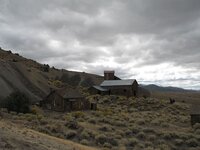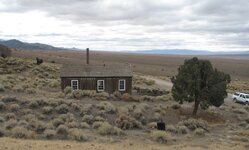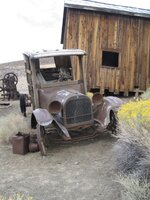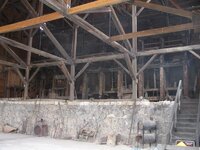Hemisteve
Sr. Member
- Feb 21, 2008
- 459
- 123
- Detector(s) used
- Goldmaster V/Sat and MXT
- Primary Interest:
- All Treasure Hunting
This is'nt really a Ghost Town, but is a great example of a turn of the century mining area in central Nevada.
We had been wanting to explore this area for years and finally had a chance last fall. You can easily spend a day here, so plan on camping out.
HH
Steve
Berlin-Ichthyosaur State Park is located 23 miles east of Gabbs, via State Route 844. The park is open all year but extreme winter weather may prohibit travel. Nestled at 7,000 feet on the scenic western slope of central Nevada's Shoshone mountain range, the park provides a vast array of stimulating recreational opportunities. The forested slopes provide shade and breezes help to moderate the summer temperatures which seldom exceed 90 F (32º C). Late spring and early fall can often be the nicest times of the year. Winter visits to the park are possible, but be certain to call for weather and road conditions.
Park Origin and History
Berlin-Ichthyosaur State Park was first established in 1957 to protect and display North America's most abundant concentration and largest known Ichthyosaur fossils at the time. The park also preserves the turn-of-the-20th century mining town of Berlin as well as the Diana Mine. The Ichthyosaur fossil area is a Registered Natural Landmark and the historic townsite is on the National Register of Historic Places. These national designations speak to the unique value of the resources preserved here.
Berlin - A Turn-of-the-Century Mining Town. The first mining activity in the region was in May 1863 when a small group of prospectors discovered silver in Union Canyon and the small mining camp of Union was settled. The following year the Union Mining District was formed, including the towns of Union, Ione, Grantsville, and later, Berlin. The first assay report in Berlin Canyon was in 1869, but is was not until 1896 that the Berlin Mine was established. With the purchase of the mine and numerous surrounding mining claims by the Nevada Company in 1898, the town of Berlin was soon in its heyday until 1908, declining to its death by 1911.
With the rise of Berlin the old settlement of Union, a mile to the east, revived as its old buildings were used by the Berlin miners. During its heyday, Berlin and its Union suburbs supported 200-250 people including miners, woodcutters, charcoal makers, a doctor and nurse, a forest ranger and a prostitute. Buildings included a 30-stamp mill, assay office, barn and corrals, union hall, store and post office, infirmary, stage station and homes. Many of the buildings still remain. Some of the residents are interred in the cemetery below the town.
The Berlin Mine was worked from an incline shaft with eight levels. The total production of its three miles of tunnels is estimated to have been $849,000 at a time when gold was $20 per once and silver was approximately 604 an ounce. The Berlin Mill processed the ore by crusher, stamps, amalgamation, and concentrating tables.
Today Berlin stands as a true Nevada ghost town, preserved for present and future generations. Visitors are invited to walk through the old townsite, read the numerous descriptive signs, peer into the windows and imagine life during this colorful period of Nevada's past.
Natural Resources:
Berlin Ichthyosaur State Park encompasses 1,540 acres. The elevation ranges from 6,840 feet to a high point of 7,880 feet. The hillsides in the park are covered with Big Sagebrush (The Nevada State Flower) while Pinyon Pine and Utah Juniper dominate the upper elevations.
Some common animal inhabitants include mule deer, black-tailed jackrabbits, cottontail rabbits, western bluebirds, pinon jays, chuckar partridge, whiptail lizards, western fence lizards, gopher snakes and rattlesnakes.
Ichthyosaurs - Mysterious Reptiles of Ancient Seas.
Ichthyosaurs (ICK-thee-o-soars) were prehistoric marine reptiles ranging in size from about two to over seventy feet in length. Ichthyosaur was the most highly specialized reptile for life in the ocean. Very fish-like in appearance and locomotion, they bore their young alive and had amazingly large eyes in relation to the rest of the body. These carnivorous reptiles ate free swimming mollusks such as ammonites, squid like creatures, and probably fish. Like all reptiles, Ichthyosaur was air breathing and resembles modern day cetaceans (whales and dolphins to which it is not related) in some of its characteristics.
Shonisaurus popularis
Living at about the same time as the dinosaurs, Ichthyosaur fossils are found on all continents except Antarctica. Their widespread existence and apparent success makes their extinction all the more mysterious. Of all the Ichthyosaurs discovered, the ichthyosaurs at Berlin-Ichthyosaur State Park (dubbed Shonisaurus popularis after the Shoshone mountain range in which they occur), are among the largest specimens known reaching fifty feet in length.
The fossilized remains of these Ichthyosaurs were discovered by Dr. Siemon Muller in 1928 in a naturally eroded area of what is now the park. Excavations began in 1954 under the direction of Dr. Charles Camp and Dr. Samuel Welles of the University of California, Berkely. Excavations by Dr. Camp continued through the 1960's with a total of about 40 Ichthyosaurs discovered in various locations throughout the park. In 1984 Shonisaurus popularis became the Nevada State Fossil. Tours of the fossil house give a glimpse not only of this fascinating creature, but a view of the actual excavation conditions encountered in modern paleontology.
The Diana Mine - A Walk Through Solid Rock.
The Diana Mine, also known as the Walter Bowler Tunnel, began operation early in the twentieth century concurrent with the boom at Berlin. It connects the surface with the fourth level of the Berlin Mine, via a lateral tunnel of over 1200 feet. Carved literally out of solid rock, the Diana Mine is much more than just a tunnel... it is a walk through the historical past. The Diana Mine remains much as it was left when activity ceased. One is left with the impression that the miners left just yesterday and will return tomorrow.
Entering the mine, visitors follows the original track laid down for the ore cart. One of the first things noticed is the cool draft characteristics of the mines and the even, year-round, temperatures. Among other period items encountered are an ore cart, side tunnels, a stope and ore chute, a winze, timbering and actual gold bearing quartz veins. Many other historical mining tools are displayed and interpreted for the visitors. Tour sizes are limited, so please call for tour availability and reservations. Effective: July l, 2007 - Mine Tours are cancelled until further notice.
Facilities:
Trails and Markers: An extensive sign system tells of the history and features of Berlin and Union for self-guided exploration. A nature trail connects the campground to the Fossil Shelter. Information and viewing windows are available at the Fossils Shelter if you cannot attend a tour program.
Entrance fee: An entrance fee is charged. THIS PARK ONLY ACCEPTS CASH AND CHECKS. Fees are also charged for camping, tours, group reservations, and commercial photography. Click here for all individual park fees by region.
Camping: 14 well-spaced units, some suitable for RVs to 25 ft, with fire ring, BBQ grill, covered table, drinking water (mid-April to October), and restrooms nearby. RV sanitary station is available.
Picnicking: Day-use picnic area with tables, grills, drinking water, and restrooms near Fossil Shelter.
Group Use: No formal group use area is available. Groups may use picnic area for day or overnight use with advanced reservations. To schedule group tours, please contact the park at the address or phone number shown.
Services: Local service information is posted in the park. Main services are provided in Gabbs, NV. No services are available at the town of Ione.
Park Programs
If reservations are required, call or FAX the park.
Berlin Townsite Tour: Self-Guided
Fossil Shelter Tour: 40 minutes; Memorial Day to Labor Day - (Monday-Friday) at 10:00 am and 2:00 pm; (Saturday-Sunday) at 10:00 am, 12;00 pm and 2:00 pm;
From March 15th to Memorial Day and Labor Day to November 15th (Saturday-Sunday) at 10:00 am and 2:00 pm (or by advance reservation, if staff is available); From November 15th to March 15th by advance reservation only, if staff is available.
We had been wanting to explore this area for years and finally had a chance last fall. You can easily spend a day here, so plan on camping out.
HH
Steve
Berlin-Ichthyosaur State Park is located 23 miles east of Gabbs, via State Route 844. The park is open all year but extreme winter weather may prohibit travel. Nestled at 7,000 feet on the scenic western slope of central Nevada's Shoshone mountain range, the park provides a vast array of stimulating recreational opportunities. The forested slopes provide shade and breezes help to moderate the summer temperatures which seldom exceed 90 F (32º C). Late spring and early fall can often be the nicest times of the year. Winter visits to the park are possible, but be certain to call for weather and road conditions.
Park Origin and History
Berlin-Ichthyosaur State Park was first established in 1957 to protect and display North America's most abundant concentration and largest known Ichthyosaur fossils at the time. The park also preserves the turn-of-the-20th century mining town of Berlin as well as the Diana Mine. The Ichthyosaur fossil area is a Registered Natural Landmark and the historic townsite is on the National Register of Historic Places. These national designations speak to the unique value of the resources preserved here.
Berlin - A Turn-of-the-Century Mining Town. The first mining activity in the region was in May 1863 when a small group of prospectors discovered silver in Union Canyon and the small mining camp of Union was settled. The following year the Union Mining District was formed, including the towns of Union, Ione, Grantsville, and later, Berlin. The first assay report in Berlin Canyon was in 1869, but is was not until 1896 that the Berlin Mine was established. With the purchase of the mine and numerous surrounding mining claims by the Nevada Company in 1898, the town of Berlin was soon in its heyday until 1908, declining to its death by 1911.
With the rise of Berlin the old settlement of Union, a mile to the east, revived as its old buildings were used by the Berlin miners. During its heyday, Berlin and its Union suburbs supported 200-250 people including miners, woodcutters, charcoal makers, a doctor and nurse, a forest ranger and a prostitute. Buildings included a 30-stamp mill, assay office, barn and corrals, union hall, store and post office, infirmary, stage station and homes. Many of the buildings still remain. Some of the residents are interred in the cemetery below the town.
The Berlin Mine was worked from an incline shaft with eight levels. The total production of its three miles of tunnels is estimated to have been $849,000 at a time when gold was $20 per once and silver was approximately 604 an ounce. The Berlin Mill processed the ore by crusher, stamps, amalgamation, and concentrating tables.
Today Berlin stands as a true Nevada ghost town, preserved for present and future generations. Visitors are invited to walk through the old townsite, read the numerous descriptive signs, peer into the windows and imagine life during this colorful period of Nevada's past.
Natural Resources:
Berlin Ichthyosaur State Park encompasses 1,540 acres. The elevation ranges from 6,840 feet to a high point of 7,880 feet. The hillsides in the park are covered with Big Sagebrush (The Nevada State Flower) while Pinyon Pine and Utah Juniper dominate the upper elevations.
Some common animal inhabitants include mule deer, black-tailed jackrabbits, cottontail rabbits, western bluebirds, pinon jays, chuckar partridge, whiptail lizards, western fence lizards, gopher snakes and rattlesnakes.
Ichthyosaurs - Mysterious Reptiles of Ancient Seas.
Ichthyosaurs (ICK-thee-o-soars) were prehistoric marine reptiles ranging in size from about two to over seventy feet in length. Ichthyosaur was the most highly specialized reptile for life in the ocean. Very fish-like in appearance and locomotion, they bore their young alive and had amazingly large eyes in relation to the rest of the body. These carnivorous reptiles ate free swimming mollusks such as ammonites, squid like creatures, and probably fish. Like all reptiles, Ichthyosaur was air breathing and resembles modern day cetaceans (whales and dolphins to which it is not related) in some of its characteristics.
Shonisaurus popularis
Living at about the same time as the dinosaurs, Ichthyosaur fossils are found on all continents except Antarctica. Their widespread existence and apparent success makes their extinction all the more mysterious. Of all the Ichthyosaurs discovered, the ichthyosaurs at Berlin-Ichthyosaur State Park (dubbed Shonisaurus popularis after the Shoshone mountain range in which they occur), are among the largest specimens known reaching fifty feet in length.
The fossilized remains of these Ichthyosaurs were discovered by Dr. Siemon Muller in 1928 in a naturally eroded area of what is now the park. Excavations began in 1954 under the direction of Dr. Charles Camp and Dr. Samuel Welles of the University of California, Berkely. Excavations by Dr. Camp continued through the 1960's with a total of about 40 Ichthyosaurs discovered in various locations throughout the park. In 1984 Shonisaurus popularis became the Nevada State Fossil. Tours of the fossil house give a glimpse not only of this fascinating creature, but a view of the actual excavation conditions encountered in modern paleontology.
The Diana Mine - A Walk Through Solid Rock.
The Diana Mine, also known as the Walter Bowler Tunnel, began operation early in the twentieth century concurrent with the boom at Berlin. It connects the surface with the fourth level of the Berlin Mine, via a lateral tunnel of over 1200 feet. Carved literally out of solid rock, the Diana Mine is much more than just a tunnel... it is a walk through the historical past. The Diana Mine remains much as it was left when activity ceased. One is left with the impression that the miners left just yesterday and will return tomorrow.
Entering the mine, visitors follows the original track laid down for the ore cart. One of the first things noticed is the cool draft characteristics of the mines and the even, year-round, temperatures. Among other period items encountered are an ore cart, side tunnels, a stope and ore chute, a winze, timbering and actual gold bearing quartz veins. Many other historical mining tools are displayed and interpreted for the visitors. Tour sizes are limited, so please call for tour availability and reservations. Effective: July l, 2007 - Mine Tours are cancelled until further notice.
Facilities:
Trails and Markers: An extensive sign system tells of the history and features of Berlin and Union for self-guided exploration. A nature trail connects the campground to the Fossil Shelter. Information and viewing windows are available at the Fossils Shelter if you cannot attend a tour program.
Entrance fee: An entrance fee is charged. THIS PARK ONLY ACCEPTS CASH AND CHECKS. Fees are also charged for camping, tours, group reservations, and commercial photography. Click here for all individual park fees by region.
Camping: 14 well-spaced units, some suitable for RVs to 25 ft, with fire ring, BBQ grill, covered table, drinking water (mid-April to October), and restrooms nearby. RV sanitary station is available.
Picnicking: Day-use picnic area with tables, grills, drinking water, and restrooms near Fossil Shelter.
Group Use: No formal group use area is available. Groups may use picnic area for day or overnight use with advanced reservations. To schedule group tours, please contact the park at the address or phone number shown.
Services: Local service information is posted in the park. Main services are provided in Gabbs, NV. No services are available at the town of Ione.
Park Programs
If reservations are required, call or FAX the park.
Berlin Townsite Tour: Self-Guided
Fossil Shelter Tour: 40 minutes; Memorial Day to Labor Day - (Monday-Friday) at 10:00 am and 2:00 pm; (Saturday-Sunday) at 10:00 am, 12;00 pm and 2:00 pm;
From March 15th to Memorial Day and Labor Day to November 15th (Saturday-Sunday) at 10:00 am and 2:00 pm (or by advance reservation, if staff is available); From November 15th to March 15th by advance reservation only, if staff is available.










